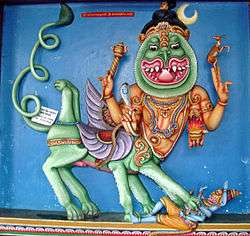Sharabha Upanishad
| Sharabha Upanishad | |
|---|---|
|
Sharabha Upanishad describes Sharabha | |
| Devanagari | शरभ |
| Title means | Part lion and part bird. |
| Author(s) | Sage Pippalada |
| Type | Shaiva |
| Linked Veda | Atharva veda |
| Chapters | 1 |
| Verses | 35 plus prologue and epilogue[1] |
The Sharabha Upanishad (Sanskrit: शरभ उपनिषत्, IAST: Sharabha Upaniṣad) is a minor Upanishads of the Atharva Veda. In a Telugu language anthology of 108 Upanishads of the Muktika in the modern era, narrated by Rama to Hanuman, it is listed at serial number 50. The Upanishad is not part of the anthology of 52 popular Upanishads in north India by Colebrooke, nor is it found in the Bibliotheca Indica anthology of popular Upanishads in south India by Narayana.[2] It is one of the 13 Shaiva Upanishads.[3][4]
The Upanishad eulogizes Lord Shiva as the Supreme Lord of the world who incarnates as Sharabha – a human-lion-bird version, to confront the human-lion Narasimha avatar of Vishnu, when Narasimha becomes destructive.[5] After slaying the Narasimha avatar, the text states that Sharabha gives the holy chakra to Vishnu.[6]
The text is also called as the "Pippaladadharmasastra," as an exposition of the knowledge by Lord Brahma to sage Pippalada.[7][8] Its title is also spelled as Sarabha Upanishad or Sharabhopanishad.
Contents
The Upanishad, after an initial prayer offering to Indra, Garuda, and Brihaspati seeking prosperity and peace to all, extols Lord Shiva or Mahesvara, in the first two verses as original God, creator of Brahma, Vishnu and other divinities, as governs the world, as the chief architect of the Vedas who conveyed it to Brahma, who dismantled the universe at the great flood, and was the Lord of Lords.[9][6]
In the third verse of the Upanishad the narration is of Shiva incarnating as Sarabha, in the form of a fierce anthropomorphic combination of eagle, lion, and man. Sarabha slays Narasimha, an incarnation of Vishnu, because he was causing destruction in the world.[6] According to the Puranas, Sarabha was one of Shiva's sixty four avatars (forms), to assist the heavenly devas and the human beings.[10]
In the fourth verse, the Upanishad states that after killing Narasimha with his claws, Sarabha wore its hide as his attire and came to be called Veera Bhadra. In the fifth verse Sarabha cuts the fifth head of Brahma, and in the sixth verse He fells Kala (time), the God of death, with his feet. He consumes Halahala, the poison that was created along with Amrita (nectar of immortality), during cosmic creation through the churning of the ocean.[9][6]
In the seventh verse, Shiva, pleased with the veneration of Vishnu, gifts him with the Chakra (holy wheel) – the iconography commonly found in one of the hands of Vishnu murtis. In the last three verses, the Upanishad assures the efficacy of Shiva to burn all sins away if they are caused and perpetuated by others.[6]
The one, who has crossed sorrows, sees that God, who is atom within an atom, gross among the gross, who as Atman hidden in the heart of beings and who is beyond physical action, clearly because of these reasons. Salutations to that Rudra who is the greatest god, who holds the Soola (trident spear) in his hand, who has a big swallowing mouth, who is the Maheswara and whose blessing has good effects.
— Sharabha Upanishad 7–8, [6]
Maheshwara's incarnation as Sarabha signifies Paramatman, combining all facets of body, mind and jeeva. Narration of the Upanishad, states the text, gives Moksha or salvation.[6]
References
- ↑ शरभोपनिषत्, Sharabha Upanishad, Archived by Sanskritdocuments.org
- ↑ Deussen, Bedekar & Palsule 1997, pp. 561-564.
- ↑ Deussen, Bedekar & Palsule 1997, pp. 556–57.
- ↑ Nair 2008, p. 580.
- ↑ Nair 2008, pp. 422, 580.
- 1 2 3 4 5 6 7 Ramachander, P. R. "Sarabha Upanishad". Vedanta Spiritual Library. Retrieved 2 December 2015.
- ↑ Desai1996, p. 109.
- ↑ Camājam & Perumanram 1979, p. 180.
- 1 2 Nair 2008, p. 422.
- ↑ Camājam & Perumanram 1979, p. 179.
Bibliography
- Camājam, Cen̲n̲ai Caiva Cittānta Makā; Perumanram, Saiva Siddhanta (1979). Saiva Siddhanta. Saiva Siddhanta Mahasamajam.
- Desai, S. G. (1996). A critical study of the later Upanishads. Bharatiya Vidya Bhavan.
- Deussen, Paul; Bedekar, V.M.; Palsule, G.B. (1 January 1997). Sixty Upanishads of the Veda. Motilal Banarsidass Publ. ISBN 978-81-208-1467-7.
- Nair, Shantha N. (1 January 2008). Echoes of Ancient Indian Wisdom. Pustak Mahal. ISBN 978-81-223-1020-7.
